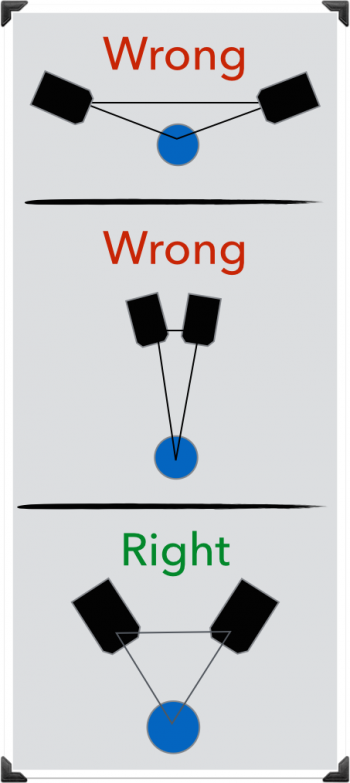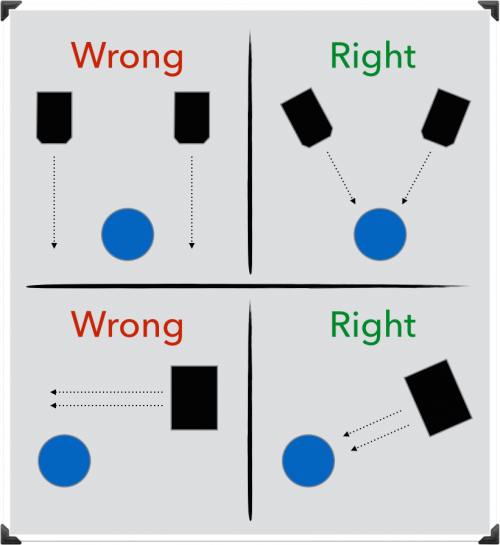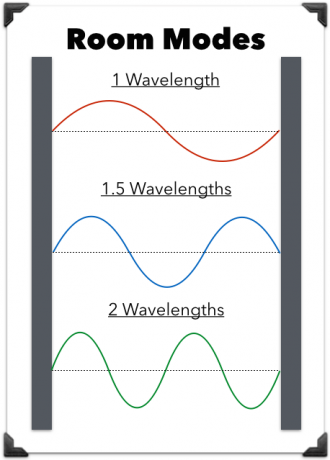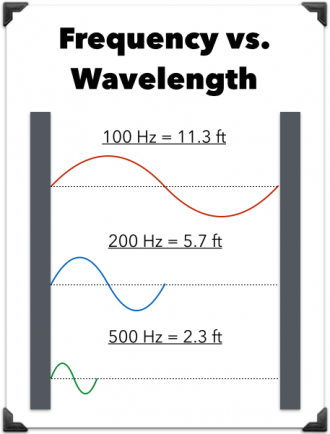
Too often, people spend far too much on studio monitors…while completely studio monitor placement.
Which is unfortunate because one of the most important steps in getting a good sound.
The fact is, a seemingly small detail like monitor placement can have an even greater impact on your sound than the monitors themselves!
Poorly-positioned…they can create HUGE peaks and valleys in the frequency response of your room, destroying any chance you had of crafting a well-balanced mix.
So for today’s post, I’m going to show you everything you need to know to avoid any of these potential pitfalls.
First up…
The Standard Mixing Position
While the exact details of this subject are endlessly debated among engineers…
For the most part, everyone can at least agree to the following 2 rules:
1. Your head should form an equilateral triangle with your monitors
The following diagram shows how it should look:

The logic here is: Without an industry standard mixing position, stereo image widths may vary drastically from one studio to another.
To solve this problem…the equilateral triangle method was likely devised as an easy-to-remember rule that offers a good compromise between too-wide and too-narrow.
The next rule is…
2. Point the monitors directly toward your head
The following diagram shows the proper setup:

The logic here is: Because high frequencies are more “directional” than low frequencies, they’re noticeably louder when the tweeters are pointed directly at you…compared to when they’re NOT.
Once again, this rule was likely developed as a way to maintain a consistent listening perspective from one studio to another.
So that covers the basics. Now let’s move on to the more-advanced stuff.
Starting with…
Room Modes Explained

The goal of monitor placement is to create an environment where a natural balance of sounds can exist, un-colored by room acoustics.
And the BIGGEST obstacle to this goal is a condition known as room modes…
Which form whenever a room’s dimensions are either:
- the same length as the sound wave, or…
- a multiple of the half-wavelength (1.5, 2, 2.5, etc.).
At those frequencies, the sound waves get trapped between opposing walls, creating what’s known as a standing wave.
This affects both the volume, and rate-of-decay of that frequency, and distorts the overall balance of the room.
When 2 or more room dimensions are equal, like in a standard 10×10 bedroom, the problem is amplified because you have twice as many standing waves at the same group of frequencies, creating even bigger spikes in the frequency spectrum
This the reason people say that cubed-rooms are the worst.
Up next…
Frequency vs. Wavelength

In a bedroom-szed studio, you typically only see problems with standing waves below frequencies of 300 Hz.
And here’s the explanation why:
At higher frequencies, sound waves are shorter…while at lower frequencies, they’re longer. For example:
- 20,000 Hz = 0.05 ft
- 10,000 Hz = 0.1 ft
- 1,000 Hz = 1.1 ft
- 500 Hz = 2.3 ft
- 200 Hz = 5.7 ft
- 100 Hz = 11.3 ft
- 20 Hz = 56.5 ft
Now, if waves and the room’s dimensions are similar in length, this is when you see the most problems.
Larger rooms are considered better, because they only struggle with waves at the lowest bass frequencies. In smaller rooms however, the problems extend much wider.
The good news is: there are solutions. So let’s learn them now…
Minimizing Standing Waves With Positioning
To minimize the effects of standing waves, it’s better to spread those waves across multiple frequencies, as opposed to having many waves, all at the same frequency.
This can be done by varying the distances between your monitors and each wall. Here’s how it’s done:
1. Position monitors against the longest wall.
When it comes to the width of your room, you really can’t vary the distances from the side-walls, because you still need to maintain a symmetrical stereo image.
In this case, the next best solution is to set up your monitors against the longest wall to minimize problems from side reflections.
Up next…
2. Vary those distances.
At this point, pull out a measuring tape and a notepad, because it’s time to compare some distances.
First off, ensure that the height of your monitors is either slightly above, or slightly below the mid-way point between the floor and ceiling.
Next, measure the distance between the monitors and the side-walls, to ensure that they’re neither the same (nor an exact multiple of) the previous two distances.
If they are, simply make adjustments and re-measure until everything looks good.
Up next…
3. Create space between the monitors and the rear wall.
Because bass frequencies project outward in all directions…much of that sound travels backwards and reflects off the rear wall of your room.
The problem is, when it recombines with the direct sound from the monitors…
The “in-phase“ frequencies get amplified, and the “out-of-phase“ frequencies cancel out. This principle is known as the boundary effect.
To solve the problem, pro studios often build their monitors directly into the wall, thus eliminating all rear reflections. (Here’s an example).
However, since this solution is far too expensive for home studios…
The next best option is to create the maximum separation between the wall and the monitors that the room-size will allow. For most rooms, that’s between 1-2 feet.
This won’t SOLVE the problem, but it will lessen it somewhat, by reducing the strength of the reflections.
Another useful trick is to use monitors with FRONT bass ports, such as the Adam Audio A7X, because unlike rear-facing bass ports, they direct a larger portion of the energy forward, AWAY from the walls.
In really small rooms, these monitors save space by allowing you to position them closer to the wall.
Up next…
4. Find a good head position
In the same way that monitor positioning has a big impact on your sound…so too does head positioning.
And so, following the same basic principles…here’s how to find the ideal position for YOURSELF:
- Center your chair between the side walls to maintain symmetrical stereo image.
- Set the chair height so your head is NOT halfway between the ceiling and floor.
- Set the chair/desk position so that it is NOT halfway between the front and back walls.
- Measure and compare the distances on all 3 dimensions to ensure they’re neither the same, nor exact multiples of each other.
Once that’s done, you’re ready for the next step…
Minimizing Standing Waves With Acoustic Treatment
Now that you’ve positioned both your monitors and chair…
Next it’s time to arrange some acoustic treatment around those two positions.
Here’s how it’s done:
1. Add bass traps behind monitors
Earlier I mentioned how reflected bass frequencies from your rear wall can cause problems.
Well the absolute BEST way to minimize those problems is to add bass traps directly behind each monitor.
If you only follow one tip from this article…FOLLOW THIS ONE. Because it makes a huge difference.
If you don’t have spare bass traps, acoustic panels or ANY other type of absorption works FAR better than nothing.
Up next…
2. Add absorption at initial reflection points
If you’re familiar with initial reflection points, then you know there are 4 KEY locations that cause the majority of problems with reflected sound from your monitors:
- Two are above your head
- One is on the left wall
- One is on the right wall
If you AREN’T familiar with them yet, here’s how to find them:
Imagine that the walls and ceiling of your room are mirrors. From your seated mixing position, the initial reflection points are the spots on the wall where you would see the reflections of your monitors.
Simply cover up those 4 spots with acoustic panels, and you’re all set.
Up next…
3. Add diffusion to the rear wall
Even though the sound waves from your monitors spread out in ALL directions…
The MAJORITY of that energy is focused directly at you…and the wall behind your head.
If that wall is flat, it’s a liability…because it has the potential to create more standing waves than any surface in the room.
However…
If that wall is covered in diffusers, it becomes an asset, because it scatters all that energy before it ever has the chance to cause problems.
Combine this tip with the 2 previous ones, and you’ve got a great recipe for success.
Up next…
Suggested Tools
Now that you’ve got a plan, here are a few links to some tools that might help you:
First, if you need acoustic treatment, check out this article:
The next item I recommend is a pair of isolation pads for your monitors. In addition to acoustically isolating your them from the desk…
They also offer a way to easily adjust tilt. For monitor placement, this has 2 advantages:
- Tilting the monitors up or down creates less potential for standing waves between the front and rear walls.
- Tilting allows you to readjust the angle towards your head as you raise or lower the height.
These are the top models I recommend:
Next, for those with a decent-sized room, I recommend adding a pair of monitor stands.
Compared to desk-shelves, these stands offer maximum flexibility with positioning, making your job a lot easier.
These are the ones I recommend:
And finally, to conclude this article:
Testing the Results of Your Work
Once you’ve completed all the steps, everything should sound good, in-theory. But just to verify it sounds good in-reality…
Some people use a test known as a bass sweep to pin-point possible problems in the low-end frequency response of a room.
Here’s an example. Check it out:
What you hear in this recording is a series of descending bass tones, played at a constant level.
To test your room, play this recording (or any equivalent) through your monitors and listen for significant changes in volume from one note to the next.
If they sound consistent, then all is well.
If NOT, chances are there’s a problem with your current setup. And unfortunately, the only way to fix it is to start over from the beginning, try again, and retest.
While it may take a few attempts to get it right, trust me when I say…
All your efforts will be well-worth-it once you hear the end-result.
By the way, if you found this post useful, I highly recommend joining our free Home Recording Secrets email newsletter where you’ll discover….
- How to Get Your First Studio Up and Running in a Single Weekend
- How to Avoid Wasting Thousands of Dollars on Unnecessary Pointless Purchases
- How to Get a “Million Dollar” Pro Studio Sound in a “Thousand Dollar” Home Studio
- PLUS… All Sorts of Other Amazing Insider Secrets Revealed
And it’s totally FREE! Click here and Enter Your Email to Sign Up.